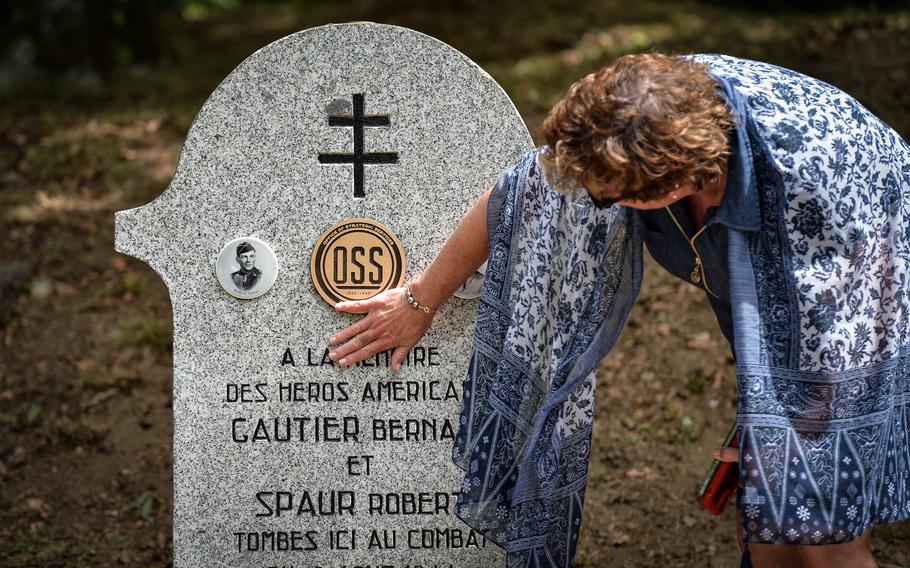
Jamie Jamison gently touches a commemorative stele that marks the area where her great uncle died in 1944 during a visit to the site near Le Rialet, France, May 28, 2022. Jamison is the great niece of Bernard Gautier, one of the two Office of Strategic Services men killed during a firefight with German troops. (Alexander Riedel/Stars and Stripes)
CASTRES, France — On June 6, 1944, U.S. troops launched the famous D-Day invasion of Nazi-occupied France.
But the fight did not stop on the beaches of Normandy.
A lesser known but outsized contribution to the war was made by the men of the Office of Strategic Services (OSS) who parachuted into the rural highlands of Southern France near Toulouse to help France’s resistance fighters in their struggle against the Nazis.
From Friday through Sunday, a group of French and American visitors headed for sites in the villages of Brassac, Boissezon, Le Vintrou and Lautrec to honor the OSS officers of Operational Group “Patrick,” or OG PAT, who parachuted behind enemy lines in 1944 to join the fight.
The visit marked the 80th anniversary of the founding of the OSS in 1942 and was spearheaded by collaboration between American expat Meredith Wheeler and Cyril Pefaure, a member of France’s Federal Union of Veterans Affairs and retired French special forces veteran.
Wheeler, who has lived in the region for almost 20 years and has written about the instrumental role of OSS operations during WWII, came across the story of the OSS after being asked to represent her nation and carry the U.S. flag during local commemoration events.
“I saw a commemorative stele naming two Americans with very French-sounding names. That made me wonder what happened here,” Wheeler said. “I knew there were no large battles fought here by American forces. I had no idea and was completely in the dark!”
A former journalist, Wheeler said she got curious and learned that the team’s story was not well documented.
“They jumped out of their aircraft at low altitude, only guided by the moonlight, into enemy territory not knowing what was ahead for them. I admired the courage, guts and determination, and their story drew me in.”
Though the French resistance had been fighting back against the Nazis for more than a year, American OSS operators and British specialists deployed together and recruited and trained locals to better fight a “shadow war” against the increasingly demoralized German forces, according to the nonprofit OSS Society.
Local men had been drafted by the Nazis and taken into forced labor camps in Germany, supporting the war effort, Wheeler said. To evade the work camps, some hid from the Germans on remote farms and in the mountains.
“They were not trained warriors,” Wheeler said. “They were farm boys, bakers and bankers.”
The OSS missions supporting civilian resistance laid the foundation for what would later become the Central Intelligence Agency in 1947. But during the war, the newly formed OSS had a broadly defined mission well beyond the scope of intelligence collection. Much of its unconventional guerrilla combat skills flowed into today’s military special operations.
During the memorial events, various French veterans’ groups laid wreaths at the stele marking the hilltop landing zone where the team first touched down.
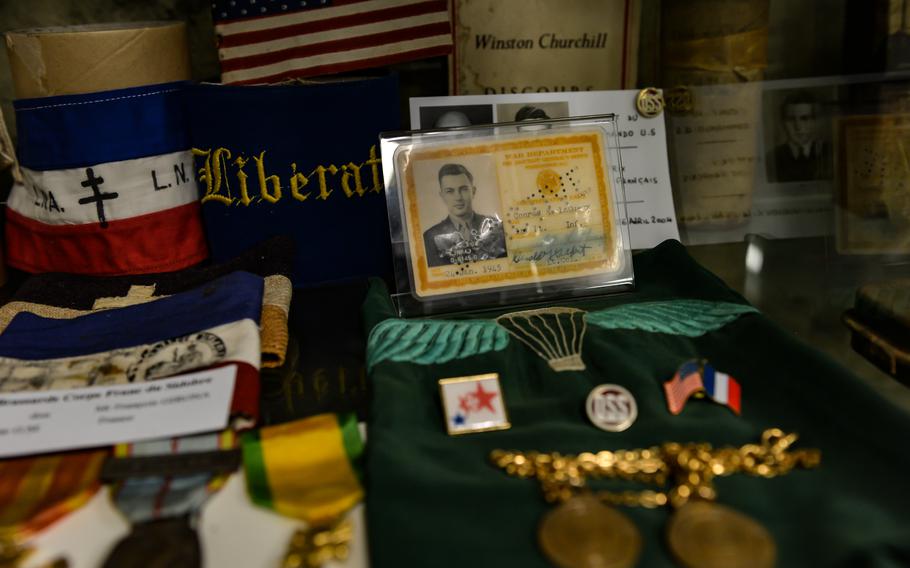
A War Department identification card for then-1st Lt. Conrad LaGueux is on display at Le Militarial museum in Boissezon, France, May 27, 2022. LaGueux led a team of Office of Strategic Services parachute team to fight alongside French resistance fighters during World War II. (Alexander Riedel/Stars and Stripes)
Night jump
Shortly after midnight on Aug. 7, 1944, an American commando team of 15 men parachuted from a British Short Stirling bomber into southern France’s Black Mountains. The team was commanded by 22-year-old Lt. Conrad LaGueux, who later became a legendary agent for the CIA and led evacuation efforts in Saigon.
To break through the excited nervousness and occasional bouts of fear during their flight from a base in Algeria, the young officer suggested they sing familiar songs to take courage, Wheeler said, citing the written memoirs of one of the paratroopers.
“I’m a Yankee Doodle Dandy, Yankee Doodle do or die ...” their voices rang over the droning engines.
After surviving a barrage of German anti-aircraft fire, the team reached the landing zone and hooked up to the static line. This was the moment they trained for. Jumping at low altitude, below 500 feet, their khaki chutes opened, slowing their descent toward the dark hills below.
Arriving within two months after D-Day cemented American foothold on French soil, their task was to pave the way for Operation Dragoon, the allied invasion along France’s Mediterranean coast which was to open an additional pressure front against Germany.
To remember this courageous leap into danger that started the mission, Pefaure organized a commemorative parachute jump into the same drop zone used 78 years prior. Five former special forces operators and an active-duty French commando paratrooper performed a demonstration jump for onlookers below.
“It is important to keep these links to our heritage,” said James King, a retired U.S. Marine Corps special operations officer and embassy staffer who was part of the demonstration jump. “Jumping into this extremely small landing site is a physical link to the past. These guys back then jumped at night, from only 400 feet with barely steerable round chutes, behind enemy lines. That’s a true commando mission and took real courage.”
The mission of OG PAT, however, was off to an ill-fated start. The central stop of the memorial events took place in the small hamlets Le Rialet and Betges, where the team, minus one member injured during landing, launched an ambush on German troops.
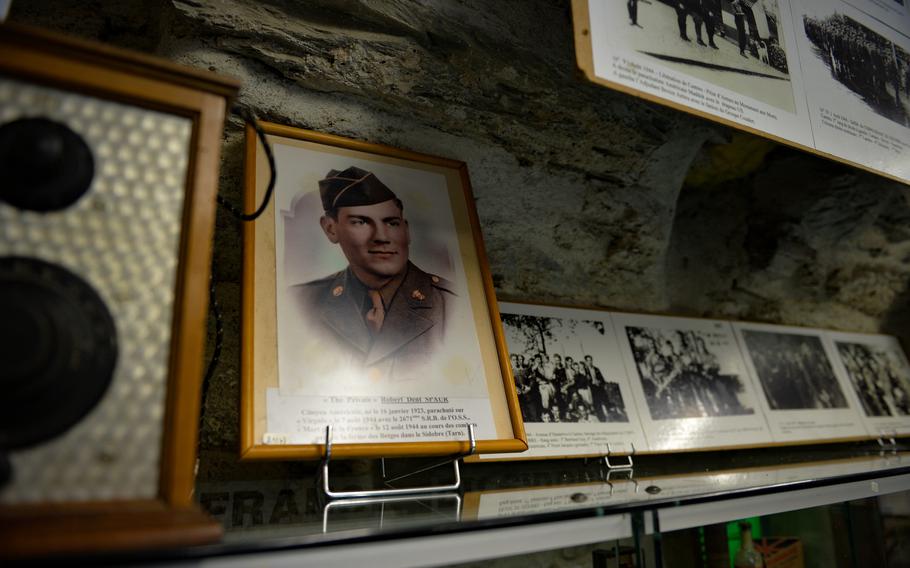
A photograph of U.S. Army Technician 5th Grade Robert Spaur is displayed at Le Militarial museum in Boissezon, France, May 27, 2022. Spaur parachuted into France’s Tarn region with Operational Group PAT of the Office of Strategic Services and was killed in action Aug. 12, 1944, during a firefight with German troops. (Alexander Riedel/Stars and Stripes)
Losing men
In the afternoon of Aug. 12, 1944, a small German convoy of motorcycle teams, equipped with sidecars and one with a machine gun, traveled to the village of Le Rialet as reinforcements after a morning skirmish with French resistance fighters, Wheeler recounted in an article for the OSS Society.
The OSS members decided to use the element of surprise to attack and fired on the first motorcycle, killing or injuring all three riders. The Germans expected an ambush, however, and the combat-experienced troops fought back with heavy machine-gun and small-arms fire against the outgunned OSS team.
While details of the firefight remain unclear, U.S. Army Sgt. Bernard Gautier tried to take out the machine gun but was shot in the back by a German handgun as he turned, Wheeler wrote, citing witness accounts of then-Lt. Michael DeMarco, an officer on the team. Technician 5th Grade Robert Spaur was hit by a burst from the German machine gun, while taking cover on the embankment.
A member of OG PAT later returned to the site to retrieve their fallen teammates with help from locals.
Gautier and Spaur were buried at the church in Le Vintrou. Both were moved to their final resting place at the Epinal American Cemetery after the war.
Seventy-eight years later, Gautier and Spaur are still remembered at two memorials, and every year French veterans organize a remembrance ceremony. A new stele was unveiled Saturday, marking the former graveside of Gautier and Spaur in the shadow of the small village church in Le Vintrou.
Jamie Jamison, the great niece of Gautier, traveled to the site with her husband and unveiled the memorial alongside the local mayor.
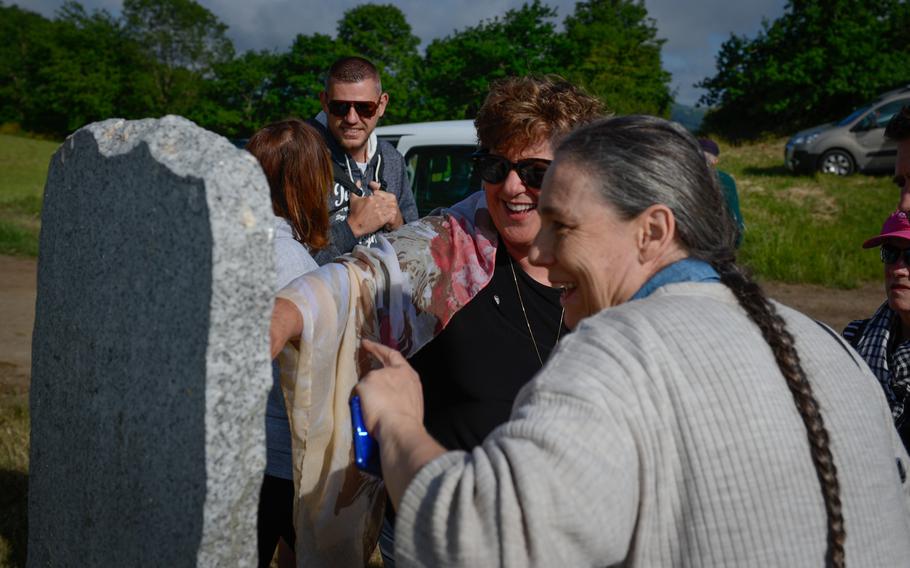
Jamie Jamison, center, talks to a French journalist about her grand uncle Bernard Gautier at the site where he landed with his small special forces paratrooper element in 1944 near Berlats, France. Gautier died six days after his arrival to France during a firefight with German troops. (Alexander Riedel/Stars and Stripes)
“It’s heartwarming to know the difference they have made for France and the Tarn region,” Jamison said. “It has been absolutely humbling to see the memory of my great uncle and his fellow OSS operatives preserved with such respect here in France. It has been an incredible journey, along with some incredible people who do wonderful work in their memory.”
In death, Gautier and Spaur were able to send a message to the local German commanders: Uniformed Americans were among their own lines, hidden in the hills around them.
Misinformation and deception through the ranks of the French locals led to false intelligence reports putting the number of Americans in the villages around the nearby city of Castres at nearly 100 when it was merely 12 Americans supporting the local resistance, Wheeler wrote.

Models of U.S. Army and French resistance uniforms are on display at the airport in Albi, France, May 26, 2022. Former French special forces paratrooper Cyril Pefaure organized various events to commemorate the landing of U.S. forces in the Tarn region of France and educate people on how American troops supported the underground fight against Nazi troops in the summer of 1944. (Alexander Riedel/Stars and Stripes)
Defiant in their grief, team members carried on with their assigned missions. The local resistance and OG PAT succeeded in blowing up a strategically important railroad bridge only two days later.
Spooked by the impact of the OSS, the Wehrmacht tried to reinforce its defenses with a resupply train full of weapons. On Aug. 19, a French resistance team aided by OG PAT succeeded in derailing the train loaded with munitions, forcing a surrender of all aboard.
That same morning 94,000 American and French forces landed on the beaches near St. Tropez, which spelled the end of German occupation in Provence.
The attack was so persuasive that the German commander yielded Castres to the partisans without another bullet needing to be fired and nearly 5,800 Nazi soldiers surrendered to the ragtag team of guerrilla fighters, according to a CIA factsheet.
“The OG PAT teams set the gold standard for covert operations. That’s how you win a war,” said Paula Doyle, a retired CIA associate deputy director of operations and now adjunct professor at Georgetown University’s Walsh School of Foreign Service. “The missions that happened here are the acorns that turned into the strong intelligence and special operations organizations we have today, and we owe deep gratitude to those men who served here in France. We continue to walk in their footsteps.”
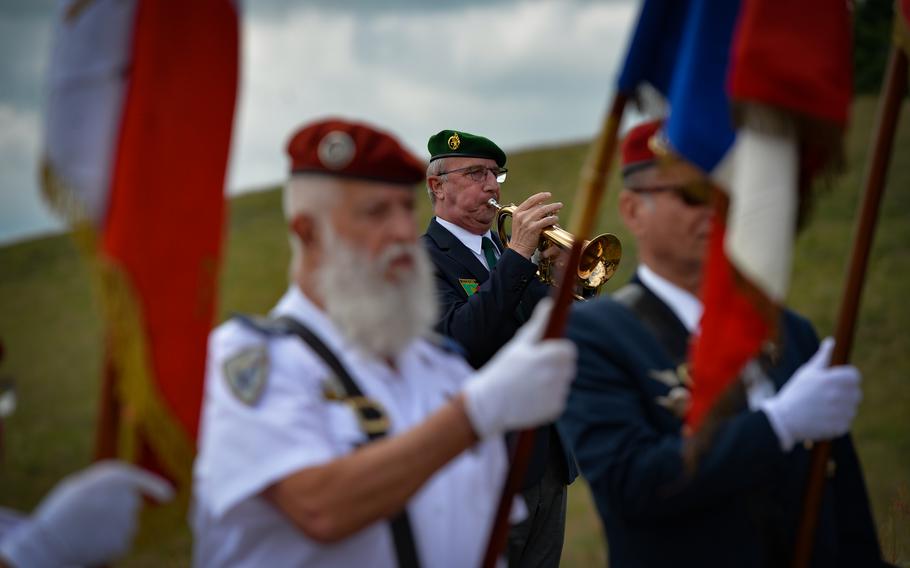
French military and police veterans attend a commemoration ceremony honoring the U.S. contributions to the regional resistance against Nazi Germany, near Berlats, France, May 27, 2022. (Alexander Riedel/Stars and Stripes)
Protecting the memory
Among the older people in the region, the missions of the OSS and the mysterious Americans jumping from the sky have long been part of local lore. For the younger generation, far removed from the experiences of war, memory of events may fade. During the ceremonies, Pefaure asked for the youngest attendants to step forward to hold banners and place commemorative memorial candles. It was a conscious step to involve the next generation, he said.
“These kinds of commemorations point to the heart of our French-American friendship,” he said “When the French needed them, the Americans were there for us. And that’s something we will not forget and hope continues far into the future. It’s important we include the next generation in the events.”
A special forces veteran of the war in Afghanistan, Pefaure said he also feels a personal connection to the operations of the small team that came to support his homeland.
“The Americans really helped us during our deployments,” he said of his experience in the Middle East. “I’ve also lost two friends during conflicts in Africa and still carry that memory. The two American casualties here therefore took on a special meaning to me. For me it is about giving back and making sure these men are never forgotten.”
Of the original group of the local resistance fighters that welcomed the Americans, only four are still alive, said George Brial, whose father Gilbert welcomed the OSS team to the village where he was hiding in 1944 and where the team found refuge in a farmhouse to hide and recuperate. Later the then-teenager used a small sub machine gun supplied by the OSS to join the fight.
The OSS agents brought not just weapons — but also chewing gum, chocolate and hope.
“The perception was these guys are skilled soldiers with good equipment,” Brial recalled his father saying. “They could help France fight back against tyranny. I only wish I would have the same courage my father and these men had.”
Now 97, Brial’s father was unable to attend the ceremonies. The last member of OG PAT died in 2008.
“Time is running out — as few of these men are still alive,” Wheeler said of the urgency to preserve their memories. Together with Pefaure, she said, she will do what she can to preserve the memories of the fallen in her adopted homeland.
During the intimate commemoration ceremonies to the daredevils who jumped into the unknown, the names of each fallen fighter were read aloud.
After Gautier and Spaur’s name, a French voice called out “Mort pour La Liberté!”
A moment of silence followed as the wind shook the leaves of oaks and beech trees surrounding the site.
They died for liberty. And the people of France remember their sacrifice.